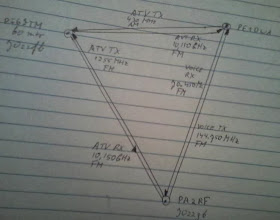Although not directly related to the radio hobby this part of the photo hobby might be interesting for you as well.
Yesterday we went to an area called Noord-Aa in Zoetermeer. I gathered some photoos with my Canon EOS1000D camera. Used a tripod for proper stabilization. The photoos I took, were a mix of overexposed, underexposed and normal exposed recordings, serving as building blocks for my first HDR pictures.
Joachim Seibert, PA1GSJ, reported on his new blog about HDR (High Dynamic Range) photography:
http://recordingphotons.blogspot.nl/2013/12/handheld-hdr-photography.html
I used the freeware program "Picturenaut3.2". This program allows you to upload a number of pictures and merge them into one picture with more/different details.
These are my first "acceptable" results:

While cleaning up my attic I found this module. Reading the label revealed that it is a switching power supply, capable of delivering 24Vdc @ 2.5 Amps.
Nice design; it is very small (appr. 10 x 5 cm) so it can be incorporated into existing designs. Have to think of an application for this 60 Watts toy.
Yesterday I had a remarkable QSO with Hans, PE1DWA.
We had set up a duplex ATV connection and a duplex voice connection.
For ATV we used the repeater frequencies of PI6ZTM (10,150 GHz out, 1255 MHz and 433 MHz in).
For voice 2 meter and 4 meter band were used: 144.750 MHz and 70.450 MHz.
So in total we used 5 different frequencies. At least remarkable.
I made a map this event:
Except for the ATV transmission on 70cm (which was in AM, one suppressed sideband) all transmissions were in FM.
Today the number of pageviews exceeded 10,000.
Thanks visitors and readers of this blog !
Happy Xmas and new year for all of you.
Today I finished the biquad antenna. It is a lightweight version of another biquad I used before. This evening I fixed the antenna onto roof.
Opening the attic window to stick the antenna outside is not necessary anymore which is good since winter temperatures are approaching.
Here you see the antenna with a bunch of RG6/U coaxial cable (10 meters)
This is how I started
To make the antenna moisture proof a transparant box was glued over the element
Antennas on the roof. In front LNB for 10 GHz RX in the back the 23 cm biquad for TX
The antenna is connected to the ATV transmitter via 10 meters of coaxial cable. I intended to buy hi frequency low loss 50 ohms coax like H100 or Aeroflex. But the prices of this type is rather high. About 4 euro's each meter. In the "Praxis" they sell RG6/U 75 ohms coaxial cable for regular satellite receiver use. A bunch of 10 meters sells for 10 euro's. I thought the difference between 50 and 75 ohms is not that much (SWR of 1:1.5 and reflected power is only 4%). This appeared to be true. My ATV signal is copied in good quality by the repeater. The specifications show that the attenuation of 10 meters RG6/U is approximately 2.5 dB at 1.2 gigahertz . Not that bad.
You can find the dimensions of the antenna in my blog article of September 2013.













